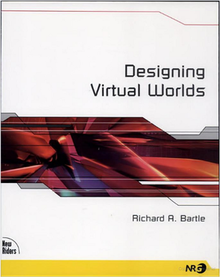A multi-user dungeon, also known as a multi-user dimension or multi-user domain, is a multiplayer real-time virtual world, usually text-based or storyboarded. MUDs combine elements of role-playing games, hack and slash, player versus player, interactive fiction, and online chat. Players can read or view descriptions of rooms, objects, other players, and non-player characters, and perform actions in the virtual world that are typically also described. Players typically interact with each other and the world by typing commands that resemble a natural language, as well as using a character typically called an avatar.
A massively multiplayer online role-playing game (MMORPG) is a video game that combines aspects of a role-playing video game and a massively multiplayer online game.
A virtual economy is an emergent economy existing in a virtual world, usually exchanging virtual goods in the context of an online game, particularly in massively multiplayer online games (MMOs). People enter these virtual economies for recreation and entertainment rather than necessity, which means that virtual economies lack the aspects of a real economy that are not considered to be "fun". However, some people do interact with virtual economies for "real" economic benefit.

Simutronics is an American online games company whose products include GemStone IV and DragonRealms. It was founded in 1987 by David Whatley, with husband and wife Tom & Susan Zelinski. The company is located in St. Louis, Missouri. It became part of the Stillfront Group in 2016.
Twinking is a type of behavior in role-playing games that is disapproved of by other players. A player who engages in such behavior is known as a twink. The precise definition of twinking varies depending on the variety of role-playing game:
DikuMUD is a multiplayer text-based role-playing game, which is a type of multi-user domain (MUD). It was written in 1990 and 1991 by Sebastian Hammer, Tom Madsen, Katja Nyboe, Michael Seifert, and Hans Henrik Stærfeldt at DIKU —the department of computer science at the University of Copenhagen in Copenhagen, Denmark.

Ancient Anguish, abbreviated AA, is a fantasy-themed MUD, a text-based online role-playing game. Founded in 1991 by Balz "Zor" Meierhans and Olivier "Drake" Maquelin, it opened to the public on February 2, 1992. It is free-to-play, but has been supported by player donations since 1994.

Furcadia is a free-to-play MMOSG/MMORPG or graphical MUD, set in a fantasy world inhabited by magical creatures. The game is based on user-created content with emphasis on world building tools, exploring, socializing, and free-form roleplaying. Furcadia hosts a large volunteer program called the Beekin Helpers, allowing players to help with community moderation, welcoming new players, handling in-game technical support, running in game events, creating art for the game itself, accessing and updating the game's website, and bug hunting. Furcadia holds the Guinness World Records title for the longest continuously running social MMORPG and, in addition to being one of the first games to heavily encourage modding and let users build virtual worlds for themselves, it was also one of the first freemium online games. In 2008, Furcadia was reported as having over 60,000 players.
Scott Jennings, also known as Lum the Mad, is an American commentator on MMORPG games. He is best known for creating a website, The Rantings of Lum The Mad, a pioneer blog, which existed from 1998 to 2001, when Jennings was hired by MMO developer Mythic Entertainment, where he remained until 2006.
A persistent world or persistent state world (PSW) is a virtual world which, by the definition by Richard Bartle, "continues to exist and develop internally even when there are no people interacting with it". The first virtual worlds were text-based and often called MUDs, but the term is frequently used in relation to massively multiplayer online role-playing games (MMORPGs) and pervasive games. Examples of persistent worlds that exist in video games include Battle Dawn, EVE Online, and Realms of Trinity.

Raphael "Raph" Koster is an American entrepreneur, game designer, and author of A Theory of Fun for Game Design. Koster is widely recognized for his work as the lead designer of Ultima Online and the creative director behind Star Wars Galaxies. From 2006 until 2013 he worked as the founder and president of Metaplace producing a Facebook game platform.

Richard Allan Bartle FBCS FRSA is a British writer, professor and game researcher in the massively multiplayer online game industry. He co-created MUD1 in 1978, and is the author of the 2003 book Designing Virtual Worlds.

The Realm Online, originally known as The Realm, is a massively multiplayer online role playing game (MMORPG) launched in December 1996 for Windows PC. It was designed in the tradition of graphical MUDs, before the usage of the terms "massively multiplayer" and "MMORPG".
A mob, short for mobile or mobile object, is a computer-controlled non-player character (NPC) in a video game such as an MMORPG or MUD. Depending on context, every and any such character in a game may be considered to be a "mob", or usage of the term may be limited to hostile NPCs and/or NPCs vulnerable to attack.
In massively multiplayer online games, an instance is a special area, typically a dungeon, that generates a new copy of the location for each group, or for a certain number of players, that enters the area. Instancing, the general term for the use of this technique, addresses several problems encountered by players in the shared spaces of virtual worlds. It is not widely known when instances were first used in this genre. However, The Realm Online (1996) is sometimes credited as introducing the concept.
Lisbeth Klastrup is a Danish scholar of digital and social media. Although her early research was on hypertext fiction, she is now best known for her research on transmedial worlds, social media and death.

The Bartle taxonomy of player types is a classification of video game players (gamers) based on a 1996 paper by Richard Bartle according to their preferred actions within the game. The classification originally described players of multiplayer online games, though now it also refers to players of single-player video games.
The history of massively multiplayer online games spans over thirty years and hundreds of massively multiplayer online games (MMOG) titles. The origin and influence on MMO games stems from MUDs, Dungeons & Dragons (D&D) and earlier social games.

LegendMUD is a text-only MUD game founded by a group of friends including virtual world designer Raph Koster. It features historically significant story elements and award-winning gameplay. It opened publicly on February 14, 1994. It has received critical praise for its research and attention to detail in reconstructing past cultures within the game context.

Avalon: The Legend Lives is a text-based online multi-player role-playing game world that was first released on 28 October 1989 at the gaming convention Adventure 89. It has maintained a continuous on-line presence with consistent and intact persona files and player history since the late 1980s, rendering it the longest continuously running on-line role-playing game in history.









